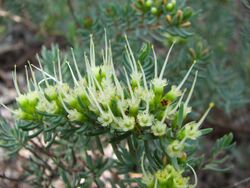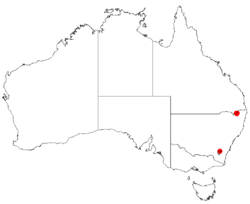Biology:Homoranthus papillatus
| Mouse bush | |
|---|---|

| |
| Homoranthus papillatus in Maranoa Gardens | |
| Scientific classification | |
| Kingdom: | Plantae |
| Clade: | Tracheophytes |
| Clade: | Angiosperms |
| Clade: | Eudicots |
| Clade: | Rosids |
| Order: | Myrtales |
| Family: | Myrtaceae |
| Genus: | Homoranthus |
| Species: | H. papillatus
|
| Binomial name | |
| Homoranthus papillatus Byrnes[1]
| |

| |
| Occurrence data from AVH | |
Homoranthus papillatus, commonly known as mouse bush,[2] is a flowering plant in the family Myrtaceae and is endemic to a small area in southern Queensland. It is a compact shrub with curved, linear leaves and pale yellow flowers arranged in upper leaf axils.
Description
Homoranthus papiillatus is small, prostrate, spreading shrub to 1 m (3 ft 3 in) high. The leaves are arranged opposite on a short petiole, linear, curved, about 10 mm (0.39 in) long with dense warty protuberances on the surface. The flowers are borne singly in upper leaf axils, light lemon-yellow, calyx tube 4 mm (0.16 in) long, 1 mm (0.039 in) in diameter, smooth, ribbed, five orbicular petals about 1 mm (0.039 in) in diameter, and a protruding style 6–9 mm (0.24–0.35 in) long, pedicel 1–2 mm (0.039–0.079 in) long. The bracts are 5 mm (0.20 in) long, dry and fall off when the flower opens. Flowering occurs from September to November and the dry fruit forms September to December.[2][3][4]
Taxonomy and naming
Homoranthus papillatus was first formally described in 1981 by Norman Byrnes from a specimen collected in Girraween National Park in 1976 and the description was published in Austrobaileya.[4][5] The specific epithet (papillatus) is a Latin word meaning "budlike".[6] The common name "mouse bush" is due to the strong odour the plant emits, that of the smell of mice.[7]
Distribution and habitat
Mouse bush is endemic to Mount Norman in Girraween National Park, Queensland where it grows in heath on skeletal sandy soils among crevices of granite outcrops.[3]
Conservation status
This homoranthus is a rare species with a highly restricted distribution and low population numbers. It has been given ROTAP conservation code 2VC-t. IUCN (2010) considered "vulnerable".[3]
References
- ↑ "Homoranthus papillatus". Australian Plant Census. https://biodiversity.org.au/nsl/services/apc-format/display/103859.
- ↑ 2.0 2.1 "Mouse bush - Homoranthus papillatus". Queensland Government Department of Enfvironment and Science. https://wetlandinfo.ehp.qld.gov.au/wetlands/ecology/components/species/?homoranthus-papillatus. Retrieved 24 August 2018.
- ↑ 3.0 3.1 3.2 Copeland, Lachlan M.; Craven, Lyn A.; Bruhl, Jeremy J. (2011). "A taxonomic review of Homoranthus (Myrtaceae: Chamelaucieae)". Australian Systematic Botany 24 (6): 351. doi:10.1071/SB11015.
- ↑ 4.0 4.1 Byrnes, Norman (1981). "Homoranthus papillatus". Austrobaileya 1 (4): 374–375. https://www.jstor.org/stable/41738621. Retrieved 10 November 2021.
- ↑ "Homoranthus papillatus". APNI. https://id.biodiversity.org.au/instance/apni/532536. Retrieved 24 August 2018.
- ↑ Brown, Roland Wilbur (1956). The Composition of Scientific Words. Washington, D.C.: Smithsonian Institution Press. p. 587.
- ↑ "Homoranthus papillatus". University of British Columbia. 12 March 2018. https://botanyphoto.botanicalgarden.ubc.ca/2018/03/homoranthus-papillatus/.
External links
Wikidata ☰ Q5891585 entry
 |

